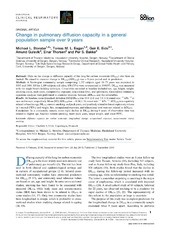Change in pulmonary diffusion capacity in a general population sample over 9 years
Storebø, Michael Langballe; Eagan, Tomas Mikal; Eide, Geir Egil; Gulsvik, Amund; Thorsen, Einar; Bakke, Per S.
Peer reviewed, Journal article
Published version

Åpne
Permanent lenke
https://hdl.handle.net/1956/19824Utgivelsesdato
2016-09-02Metadata
Vis full innførselSamlinger
Originalversjon
https://doi.org/10.3402/ecrj.v3.31265Sammendrag
Rationale: Data on the change in diffusion capacity of the lung for carbon monoxide (DL_CO) over time are limited. We aimed to examine change in DL_CO (ΔDL_CO) over a 9-year period and its predictors. Methods: A Norwegian community sample comprising 1,152 subjects aged 18–73 years was examined in 1987 and 1988. Of the 1,109 subjects still alive, 830 (75%) were re-examined in 1996/97. DL_CO was measured with the single breath-holding technique. Covariables recorded at baseline included sex, age, height, weight, smoking status, pack years, occupational exposure, educational level, and spirometry. Generalized estimating equations analyses were performed to examine relations between ΔDL_CO and the covariables. Results: At baseline, mean [standard deviation (SD)] DL_CO was 10.8 (2.4) and 7.8 (1.6) mmol·min−1·kPa−1 in men and women, respectively. Mean (SD) ΔDLCO was −0.24 (1.31) mmol·min^−1·kPa^−1. ΔDL_CO was negatively related to baseline age, DL_CO, current smoking, and pack years, and positively related to forced expiratory volume in 1 second (FEV_1) and weight. Sex, occupational exposure, and educational level were not related to ΔDL_CO. Conclusions: In a community sample, more rapid decline in DL_CO during 9 years of observation time was related to higher age, baseline current smoking, more pack years, larger weight, and lower FEV_1.
